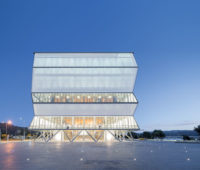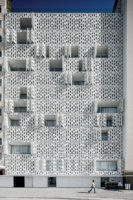When friends and ad-agency partners Rodrigo Mizala and Juan Martínez decided to construct neighboring residences for themselves and their families, they came at the project with a common fundamental desire: they hoped to capture the spirit of a vacation home, but instead of building in the mountains or at the beach, they would do it in Santiago, Chile’s pulsating capital.
While the two houses would be completely separate, each would convey a communal ethos. “We wanted homes centered on a space our families could share—where we could cook, eat, and relax together as we do when we are on holiday,” says Mizala. “Our idea was to break down the walls between the kitchen, dining, and living rooms—walls that often end up creating dead spaces.” The model Mizala had in mind was his own summer house in the pretty town of Puerto Varas, 600 miles south of the capital in Chile’s Alpine Lake District where he, his wife, and teenage children reconnect, thanks in part to the intimate living quarters and its informal, open plan.
Taking on the two clients’ request for a tranquil retreat in the middle of the city, Santiago-based Smiljan Radic envisioned the Casas Pareadas—or Paired Houses—as three interconnected volumes which, split by a dividing wall, contain two distinct, though mirror-image homes—Casa A and Casa B. Seeking to create a “microenvironment” with each abode, Radic looked for inspiration to the low-slung 1960s houses that dot Santiago, wrapping the domestically scaled building around generous gardens.
By placing two rectilinear lower volumes parallel to one another and topping them with a perpendicularly oriented bar, Radic set up a dynamic dialogue between the interiors and exteriors. This conversation was further charged by his decision to sink the lower spaces a couple of feet into the ground—a move that brings the scale down and imbues the house with an organic quality, making it seem as if it sprouted out of its lush site. The interplay between the volumes creates a variety of outdoor spaces. Two covered patios are formed where the upper level straddles a void, and lead out to the gardens beyond, while terraces on the roofs of the lower levels offer views to Mount Manquehue, the highest peak in the Santiago Basin.
The relaxed atmosphere articulated by the spatial organization is further enhanced by Radic’s use of materials. Terraces employ unadorned white flagstones. Interior floors and ceilings are of warm Alamo wood, and concrete walls, which carry from the exteriors into the living spaces, are painted a warm charcoal black, standing in contrast to the current vogue among Santiago’s elite for immaculate white interiors.
This project is not the first that Mizala and Martínez built together, having previously erected a three-unit residence in Santiago for themselves and a third friend. Searching for a designer for what would become Casas Pareadas, the pair was drawn to Radic, the architect behind the much ballyhooed 2007 Restaurant Mestizo, whose breezy monumentalism graces a new city park. A subsequent visit to one of Radic’s private residences ended their quest. “I was fascinated by Smiljan’s use of materials to create ambience,” says Rizala, a graphic designer by training. “He finds beauty in the primitive sophistication of ordinary workaday materials, so that they bolster the informal spirit of the house.”
The finished product the architect delivered differs very little from the first wooden model he showed the clients just a month after first meeting them. Not surprisingly, the houses’ emotional centers are on the lower levels. Here, column-free spaces contain the expansive integrated living areas that Mizala and Martínez so dearly wanted. Entered off the low, unassuming street-facing facade through a small foyer, each of the residences’ social areas flows from the kitchen and on into the dining and sitting areas. In each, beyond a poured-in-place concrete wall, lies the master bedroom, which spills out onto a sunken terrace at the end of the garden by the swimming pool. Upstairs, the Alamo wood brings a glow to the bedrooms and ateliers, which is amplified by high ceilings and abundant daylighting.
The only significant difference between the two otherwise identical houses is found on the lower levels. Casa A is pulled away from the wall of its other neighboring property, allowing for floor-to-ceiling windows along both sides of the living area. Planning and space restrictions meant Casa B’s lower level is attached to the wall that divides the units, so it has glazing exclusively on the north elevation, facing its own private garden.
Completed in 2014, the residence has evolved, just as planned, as an urban oasis for the two families. “Smiljan has created a home where you always feel relaxed,” says Rizala. “It makes for a wonderful family life.” For Radic, whose international profile has risen since Casas Pareadas was completed, the design displays the restraint that is one of his signatures. “The project offers an austere facade to the street, so as not to disrupt the urban fabric,” he says, describing the inward-looking compound. “This idea of austerity and a building’s impact on the public sphere has been there in my work from the beginning.”
CreditsArchitect: Smiljan Radic
Collaborating architect: Loreto Lyon
Engineer: B y B ingeniería (structural)
|
Specifications |

















Post a comment to this article
Report Abusive Comment